Introduction to Food and Pharma Butterfly Valves
Food and pharma butterfly valves are pivotal components in both the food and pharmaceutical industries. They effectively control the flow of fluids and gases within processing equipment, meeting stringent requirements for hygiene, sterility, and non-contamination.
Design and Material Specifications
These specialized valves comprise three primary components:
- Valve Body: Connects directly to processing equipment.
- Valve Stem: Rotates to manage the flow of fluids or gases.
- Disc: Seals tightly against leakage, constructed to withstand corrosion and chemical damage.
Constructed from high-quality materials like stainless steel, these valves ensure durability. Their design allows for easy cleaning and sanitization, reducing potential contaminant accumulation.
Operational Flexibility
Food and pharma butterfly valves can be manually operated or automated. Automated versions integrate seamlessly into larger process control systems, enhancing overall processing efficiency and control.
Applications in the Food Industry
These valves are extensively utilized across various food processing segments:
- Dairy Products: Aid in processing milk, yogurt, and cheese.
- Beverages: Implemented in the production of soft drinks, juices, and alcoholic beverages.
- Sauces and Condiments: Used in managing the flow of liquid ingredients.
- Confectionery: Critical in chocolate and other sweets manufacturing.
Technological and Market Trends
The demand for food and pharma butterfly valves is rising, fueled by the call for improved efficiency and the trend towards automation in manufacturing environments. The global market for these valves, as reported by MarketsandMarkets, is expected to grow with an annual CAGR of 4.3% from 2020 to 2025.
Regional Market Insights
North America and Europe currently dominate the market due to well-established industries and regulatory frameworks. Meanwhile, the Asia-Pacific region shows the highest growth potential, driven by increased demand for food and pharmaceutical products and the adoption of automation technologies.
Market Competition and Outlook
The competitive landscape features key players like GEA Group AG, Alfa Laval AB, and The Weir Group PLC, among others. The market outlook remains optimistic due to the continual focus on hygiene, efficiency, and sustainability within the industries.
Conclusion
As critical components in processing systems, food and pharma butterfly valves support the seamless operation of the food and pharmaceutical industries. Their future appears robust with ongoing developments in technology and market expansion, reflecting the continuous need for innovative and hygienic processing solutions.
 PMG stands for Projects Management Group. We provide state-of-the-art Engineering Services to build world-class food processing factories.
PMG stands for Projects Management Group. We provide state-of-the-art Engineering Services to build world-class food processing factories.  Engineering is the difference between Chaos and Excellence. If you are going to do it, do it right.
Engineering is the difference between Chaos and Excellence. If you are going to do it, do it right.  Explore the diverse range of Products in the Food Processing Industry.
Explore the diverse range of Products in the Food Processing Industry.  Explore the technologies at the heart of the the Food Processing Industry.
Explore the technologies at the heart of the the Food Processing Industry. 


 Back
Back 



